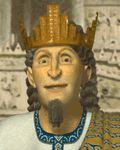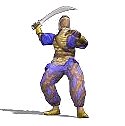The Persians |
|||||||||||||||||||||||
| Profile | |||||||||||||||||||||||
|
|||||||||||||||||||||||
|
Persian Cities
Great Leaders
|
Background
The term Persia has been used for centuries, chiefly in the West, to designate a region of southern Iran formerly known as Persis or Parsa, the name of the Indo-European nomadic people who migrated into the region about 1000 BC, eventually supplanting the Assyrians and Chaldeans. The first mention of the Parsa occurs in the annals of Shalmanesar III, an Assyrian king, in 844 BC. Cyrus II (559-529 BC), heir to a long line of ruling chiefs in Mesopotamia, was a tolerant and venerated monarch, called the father of his people by the ancient Persians. After a successful revolt against his Achaemenian overlords in 550 BC and inheriting the kingdom of the Medes, Cyrus consolidated his rule on the Iranian Plateau and extended it westward across Asia Minor. In October 539 BC, Babylon, the greatest city of the ancient world, fell to his Persian forces. Following the death of Cyrus’ heir, Darius I (522-486 BC), a leading general and one of the princes of the Achaemenid family, proclaimed himself king following suppression of a number of provincial rebellions and challenges from other pretenders to the throne. Darius was in the mold of Cyrus the Great – a powerful personality and a dynamic ruler. To consolidate his accession, Darius I founded his new capital of Parsa, known to the Greeks as Persepolis (“Persian City”) and expanded the ranks of his personal bodyguard, the Immortals. Although Darius consolidated and added to the conquests of his predecessors, it was as an administrator that he made his greatest contribution to Persian history. During his reign, political and legal reforms revitalized the provinces and ambitious projects were undertaken to promote imperial trade and commerce; coinage, weights and measures were standardized and new land and sea routes explored and established. Such activities, however, did not prevent Darius from following an active expansionist policy. Campaigns in the east confirmed gains made by Cyrus the Great and added large sections of the northern Indian subcontinent to the list of Persian-controlled provinces. Expansion to the west began about 516 BC when Darius moved against the Greek colonies along the coast of Asia Minor. Xerses (486-465 BC), son and successor of Darius I, was determined to continue the Persian conquest of the west and is best known for his massive invasion of Greece from across the Hellespont in 480 BC, a campaign marked by the battles of Thermopylae, Salamis and Plataea. Although successful in the pacification of Egypt and suppression of a Babylon revolt, his defeat by the allied Greek city-states spelled the beginning of the decline of the Persian Empire. Soured by these reversals, Xerxes retired to his palaces at Susa and Persepolis. In his last years, he squandered the once-enormous treasury he had gathered through trade and taxation by launching vast construction programs, most never finished. The death of Xerxes was the final turning point in Persian influence. Occasional flashes of vigor and ability by some of Xerxes’ successors were too infrequent to prevent eventual collapse. The final act was played out during the reign Darius II (423-404 BC), who rose to the throne through palace intrigue. Darius was able to put down yet another rebellion in Egypt in 337-336 BC, but the beginning of the end came soon afterward with his defeat at the Battle of Granicus (334 BC) by Alexander the Great. Persepolis fell to the young Macedonian conqueror in April 330 BC, and Darius, the last Achaemenid, was murdered in the summer of the same year while fleeing the Greek forces. In the struggle for power after Alexander’s death, Seleucus I brought under his control the Persian provinces of Alexander’s empire. But this unity was short-lived, as the Indian holdings successfully revolted and the Seleucid kingdom broke into the competing nations of Parthia and Bactria. The last vestiges of Persian culture disappeared with the advent of Islam and the Arab conquest (640-829 AD) of Iran. Unique Unit: the Immortals The Immortal is an upgraded version of the swordsman. Like the swordsman, it requires iron to build, but the bonus to its attack rating makes it a very potent offensive unit, and its defense rating of 2 rounds out its standing as a good all-purpose unit.
|
||||||||||||||||||||||

 The Persians are industrious and scientific. They start the game with Masonry and Bronze Working and build Persian Immortals instead of swordsmen.
The Persians are industrious and scientific. They start the game with Masonry and Bronze Working and build Persian Immortals instead of swordsmen. The Immortals were the elite corps of the Persian army, as well as the king’s personal bodyguards, and only those of Persian or Medic descent were allowed to serve. Equipped with bows, spears, a short sword, and little else, the Immortals relied on superior numbers and high morale to defeat their foes. Immortals also carried lightweight wicker "shields" that could deflect arrows, but they were of little use in melee combat against more heavily armored and better equipped forces. Ironically, they were called Immortals because they would often perish quickly in combat, only to be immediately replaced by fresh troops, giving the illusion that their forces never dropped in strength. Apparently, "Expendables" didn’t have quite the same ring to it.
The Immortals were the elite corps of the Persian army, as well as the king’s personal bodyguards, and only those of Persian or Medic descent were allowed to serve. Equipped with bows, spears, a short sword, and little else, the Immortals relied on superior numbers and high morale to defeat their foes. Immortals also carried lightweight wicker "shields" that could deflect arrows, but they were of little use in melee combat against more heavily armored and better equipped forces. Ironically, they were called Immortals because they would often perish quickly in combat, only to be immediately replaced by fresh troops, giving the illusion that their forces never dropped in strength. Apparently, "Expendables" didn’t have quite the same ring to it.